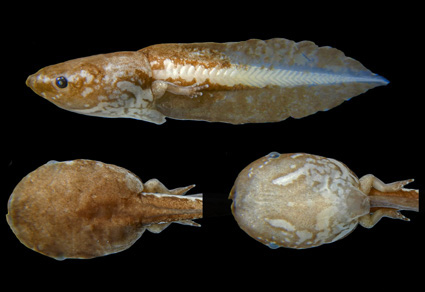References
- Altig, R. & McDiarmid, R.W. (1999) Body plan: development and morphology. In: McDiarmid, R.W. & Altig, R. (Eds.), Tadpoles: The Biology of Anuran Larvae. The University of Chicago Press, Chicago and London, pp. 24–51.
- Araujo-Vieira, K., Tacioli, A., Faivovich, J., Orrico, V.G.D. & Grant, T. (2015) The tadpole of Sphaenorhynchus caramaschii, with comments on larval morphology of Sphaenorhynchus (Anura: Hylidae). Zootaxa, 3904 (2), 270–282. https://doi.org/10.11646/zootaxa.3904.2.6
- Bokermann, W.C.A. (1966) Lista Anotada das Localidades Tipo de Anfíbios Brasileiros. Servicio de Documentacão, Universidade Rural São Paulo, São Paulo, 183 pp.
- de Sá, R.O., Streicher, J.W., Sekonyela, R., Forlani, M.C., Loader, S.P., Greenbaum, E., Richards, S.J. & Haddad, C.F.B. (2012) Molecular phylogeny of microhylid frogs (Anura: Microhylidae) with emphasis on relationships among New World genera. BMC Evolutionary Biology, 12, 1–21. https://doi.org/10.1186/1471-2148-12-241
- Dias, I.R., Mira-Mendes, C.V. & Solé, M. (2014) Rapid inventory of herpetofauna at the APA (Environmental Protection Area) of the Lagoa Encantada and Rio Almada, Southern Bahia, Brazil. Herpetology Notes, 7, 627–637.
- Dixo, M. (2004) Rediscovery of Hyophryne histrio (Anura, Microhylidae) in Atlantic Forest remnants of Bahia, northeastern Brazil. Phyllomedusa, 3, 77–79. https://doi.org/10.11606/issn.2316-9079.v3i1p77-79
- Donnely, M.A., de Sá, R.O. & Guyer, C. (1990) Description of the Tadpoles of Gastrophryne pictiventris and Nelsonophryne aterrima (Anura: Microhylidae), with a review of morphological variation in free-swimming microhylid larvae. American Museum Novitates, 2976, 1–19.
- Dubeux, M.J.M., do Nascimento, F.A.C., Lima, L.R., Magalhães, F.de M., da Silva, I.R.S., Gonçalves, U., de Almeida, J.P.F.A., Correia, L.L., Garda, A.A., Mesquita, D.O., Rossa-Feres, D. de C. & Mott, T. (2020) Morphological characterization and taxonomic key of tadpoles (Amphibia: Anura) from the northern region of the Atlantic Forest. Biota Neotropica, 20, 1–24. https://doi.org/10.1590/1676-0611-bn-2018-0718
- Faivovich, J., Haddad, C.F.B., de A. Garcia, P.C., Frost, D.R., Campbell, J.A. & Wheeler, W.C. (2005) Systematic review of the frog family Hylidae, with special reference to Hylinae: A phylogenetic analysis and taxonomic revision. Bulletin of the American Museum of Natural History, 294, 1–240. https://doi.org/10.1206/0003-0090(2005)294[0001:SROTFF]2.0.CO;2
- Frost, D.R. (2024) Amphibian species of the world: an online reference, electronic database. Version 6.2. American Museum of Natural History, New York, New York. Available from: https://amphibiansoftheworld.amnh.org/index.php (accessed 24 July 2024)
- Gosner, K.L. (1960) A simplified table for staging anuran embryos and larvae with notes on identification. Herpetologica, 16, 183–190.
- Grosjean, S. (2005) The choice of external morphological characters and developmental stages for tadpole-based anuran taxonomy: a case study in Rana (Sylvirana) nigrovittata (Blyth, 1855) (Amphibia, Anura, Ranidae). Contributions to Zoology, 74, 61–76. https://doi.org/10.1163/18759866-0740102005
- Lavilla, E.O. & Scrocchi, G.J. (1986) Morfometría larval de los géneros de Telmatobiinae (Anura: Leptodactylidae) de Argentina y Chile. Physis, 44, 39–43.
- Mira-Mendes, C.V., Ruas, D.S., Oliveira, R.M., Castro, I.M., Dias, I.R., Baumgarten, J.E., Juncá, F.A. & Solé, M. (2018) Amphibians of the Reserva Ecológica Michelin: a high diversity site in the lowland Atlantic Forest of southern Bahia, Brazil. ZooKeys, 753, 1–21. https://doi.org/10.3897/zookeys.753.21438
- Palumbi, S.R. (1996) Nucleic acids II: The polymerase chain reaction. In: Hillis, D.M., Moritz, C. & Mable, B.K. (Eds.), Molecular Systematics. Sinauer Associates, Inc., Sunderland, Massachusetts, pp. 205–247.
- Pezzuti, T.L., Leite, F.S.F., Rossa-feres, D. & Garcia, P.C.A. (2021) The tadpoles of the Iron Quadrangle, southeastern Brazil: a baseline for larval knowledge and anuran conservation in a diverse and threatened region. South American Journal of Herpetology, 22, 1–107. https://doi.org/10.2994/SAJH-D-20-00042.1
- Wogel, H., Abrunhosa, P.A. & Pombal, J.P. (2000) Girinos de cinco espécies de anuros do Sudeste do Brasil (Amphibia: Hylidae, Leptodactylidae, Microhylidae). Boletim do Museu Nacional. Zoologia, 427, 1–16.


